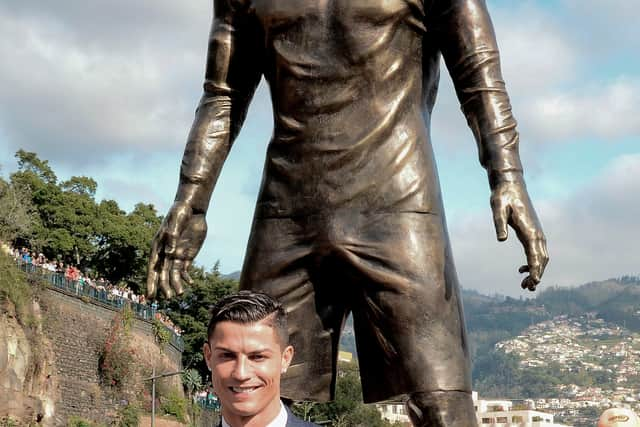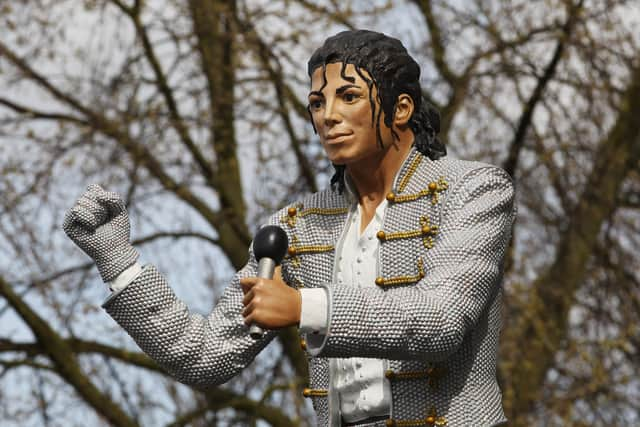Football’s most bizarre statues: including ex-Man Utd and Newcastle United heroes
and live on Freeview channel 276
“Art is not truth”, as Pablo Picasso once said. It is, therefore, with some relief that we can infer that the freshly-unveiled statue of Marcelo Gallardo, the legendary Argentinian coach who guided River Plate to two Copa Libertadores trophies, does not necessarily tell us anything honest about the proportions of his pelvic package.
Stood outside the Estadio Monumental, the appropriately monumental statue stands 26 feet tall and weighs seven tons – much of which is down to the substantial and extremely prominent bulge in Gallardo’s nether regions. Generations of fans in Buenos Aires will now march to their seats in the shadow of what must surely be the largest testicles ever committed to bronze.
Advertisement
Hide AdAdvertisement
Hide AdMuch fun has already been had on social media at the expense of the generous gonads, which are, according to artist Mercedes Savall, intentional – “a gesture to the fans”, apparently, which I’m sure they appreciate – and a reference to the slang of the stands which incorporates supporters demanding that the players ‘put a lot of eggs into it’, a relatively straightforward euphemism for us foreigners to decode.
The sculptor continued that it is a “subliminal message through the sculpture”, although quite how subliminal a colossal crotch can really be when it dangles several metres above the viewer is up for debate. In any case, it isn’t the first time that art and football have struggled to meld together, and isn’t even the first time that exaggerated genitals have been the problem.
Cristiano Ronaldo has been the subject of quite a few questionable sculptures in recent years, the most famous of which will always be the manically-grinning bust that gurned at visitors to the Cristiano Ronaldo International Airport in Madeira like a happy hardcore fan at 4am - but he was also present at the unveiling of a full-size cast bronze piece erected (ahem) in his hometown of Funchal which displayed a needlessly prominent growth in the region of his privates, helpfully accentuated by the flowing lines of his shorts rising to meet it.
Perhaps the artist added it to distract from the fact that the piece looks more like Jack Wilshere than the ex-Man Utd player, or perhaps there were just a fair few hormones washing around the sculptor’s workshop. Or maybe it’s just a symptom of the challenge of rendering the free-flowing movement and easy athleticism of a professional footballer in rigid metal – or we’re overthinking it, and Ronaldo simply added a few notes in the margin when he was presented with the original blueprints.
Advertisement
Hide AdAdvertisement
Hide Ad

While we must grant that the budgets for such statues rarely allow for Michelangelo to be resurrected and place in charge of the project – or any of the other Ninja Turtles for that matter - it’s still astonishing how many dreadful monuments grace the great stadiums of the game. There was the woeful statue of Southampton’s former player and manager Ted Bates, which was removed after a week and later replaced for the simple reason that it looked nothing like its subject. Then there’s the rather iffy effort honouring Alan Shearer outside St. James’ Park, which can only be easily identified as Newcastle United’s former forward because of the trademark celebratory pose.
Not that there aren’t plenty of fine sculptures celebrating the great and good of the game dotted around the footballing landscape, of course, but the hit rate is certainly less impressive that one might hope. Capturing every line and crease of an athlete’s face whilst also generating a powerful impression of graceful movement and physical prowess is a puzzle that has proven beyond the skills of many artists. Which is fair enough, of course – it’s hardly the same as putting together a papier-mâché Tracey Island, and most of were rubbish at that when we were at school.
No article about footballing statuary, regardless of how much time it spends pretentiously pondering the artistic challenges involved, can avoid mention of the famously bizarre plaster and resin statue of Michael Jackson that incongruously towered over the concourse outside Craven Cottage – and later spent four years bemusing visitors to the National Football Museum.


The ludicrously stilted statue of the King of Pop, all awkward angles and lumpen attempts at sequins, was removed from Fulham’s ground after Shahid Khan bought the club in 2013 – and when the club were relegated the following season, former chairman Mohamed Al-Fayed blamed the team’s downturn in fortunes on the decision to take the statue down. You’d think that, if such monuments have the power to influence a team’s performances, the clubs involved could put a bit more effort into them.
We want your feedback on 3 Added Minutes - details here
Advertisement
Hide AdAdvertisement
Hide AdBut then, football’s bigwigs – grey-suited businessmen and oil-stained tycoons to a man (and they overwhelmingly are men) – aren’t necessarily in touch with the muses. Club chairmen don’t rise to their positions for their appreciation of the human form or their understanding of the nuances of modern art. So perhaps we shouldn’t be surprised when so many of the monuments erected in memory and appreciation of the game’s greats come out of the creative process looking dreadful – and perhaps we should just be grateful for all the cheap laughs when they come out with pubic protuberances the size of our heads.
Comment Guidelines
National World encourages reader discussion on our stories. User feedback, insights and back-and-forth exchanges add a rich layer of context to reporting. Please review our Community Guidelines before commenting.
